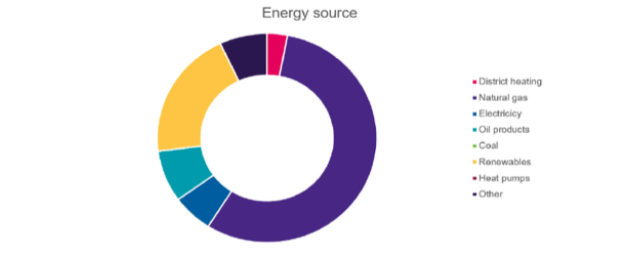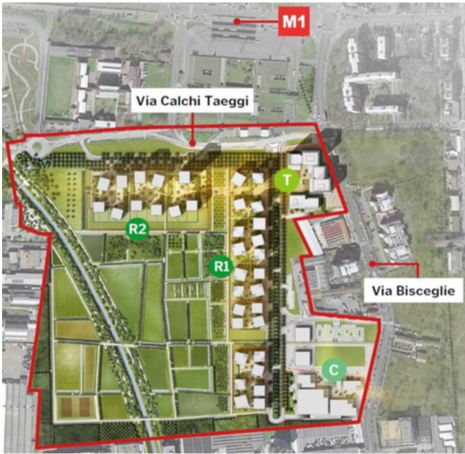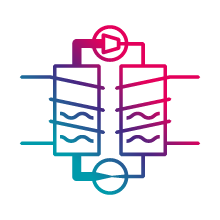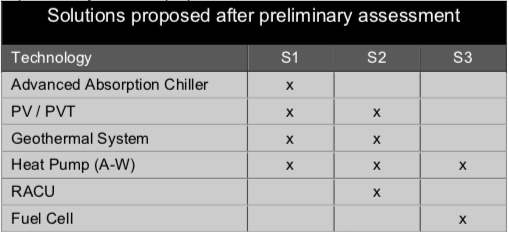Context
In 2017, only 3% of Italy’s heating demand came from district heating, while 56% came from natural gas, 8% came from oil (or petroleum products), and 6% came from electricity.

This means that there is a significant potential for reducing Italy’s carbon footprint by converting private gas- and oil-fired central heating systems to parts of city-wide DHC systems using one or more WEDISTRICT technologies for DHC production.
Area
The area in question is part of an impressive urban regeneration project, which will lead to the creation of an innovative multifunctional district integrated in a park. It is located south-west of Milan, between Via Calchi Taeggi and Via Bisceglie, adjacent to the metro terminus (M1). Heating and cooling will be provided via DHC networks by the local utility A2A, one of Italy’s largest multiutilities.
The area consists of approx. 115,000 m2, where the following lots will be built:
- Lot “R1”: planned to consist of 6 blocks of residences for a total of 550 flats
- Lot “R2”: planned to consist of 470 flats, currently being designed.
- Tertiary Lot, “T”

The project started in 2019 and the delivery of the first real estate units is planned for 2022.
Energy demand
SeiMilano has two types of energy demands:
District heating
to a number of buildings; not yet finally clarified, approx. 1,020 apartments.
District cooling
to a number of buildings; not yet finally clarified, approx. 1,020 apartments.

Main data about planned construction:

Absorption chillers (heat pumps)
A number of absorption chillers (heat pumps) will be installed; the pumps must provide heat in the wintertime and cooling during summertime.

Compression heat pumps (conventional heat pump)
A compression heat pump (conventional heat pump) will also be installed to support the absorption chillers (heat pumps) in case they can not deliver the required cooling.

Groundwater (geothermal system)
It is planned to pump up cooling groundwater and use it to ensure the condensation of the refrigerant in the chillers (heat pumps). The geothermal system thereby introduces a refrigerant condensation insurance from the cooling groundwater. The heated groundwater will be pumped out into a stream that runs through the nearby green area (a park).

PV panels
Several PV panels will be installed on the roofs of houses and buildings to supply the buildings' electricity consumption. They are also seen as an electrical storage solution, being connected to the electrical grid. In Italy, it is a legal requirement that PV panels are installed on new or heavily renovated buildings.
Use of PV-T instead of PV panels
It is suggested to investigate the use of PV-T instead of PV panels as an optimisation.
Proposed technologies
Advanced Absorption Chiller
Investigation of the performance and operation of the WEDISTRICT advanced absorption chiller compared to a conventional absorption chiller.

Renewable Air-Cooling Unit (RACU)
Investigation of the option of applying a RACU to deliver cooling instead of the absorption chiller solution(s).

Photovoltaics/PV (+Thermal)
It is suggested to investigate the use of PV-T instead of PV panels as an optimisation and compare possible PV and PVT solutions (possibly with tracking mirrors) as a possibility to increase the electrical and thermal outputs. The WEDISTRICT PV-geothermal hybrid will also be considered. Several PV panels will be installed on the roofs of the buildings, since it is a legal requirement that PV panels will be installed on new or heavily renovated buildings. PVT is proposed as an optimization to this, possibly replacing part of the PV.

Geothermal System
Investigation of the option of a geothermal system layout, as already mentioned in the planned construction, as well as the possible integration of the WEDISTRICT PV-geothermal hybrid solution.

Heat Pump (A/W) / Chiller
Investigation of the performance and operation of an absorption chiller (heat pump) compared to a (conventional) compression heat pump. A number of absorption chillers (heat pumps) is planned to be installed in order to provide heat in the wintertime and cooling in the summertime. In addition, a compression heat pump will be installed to assist the absorption chillers (heat pumps), if the absorption cannot deliver the required cooling, as already mentioned in the planned construction.
Fuel Cell
Investigation of the application of a fuel cell to deliver power and heat to homes, offices, and businesses in combination with an air-to-water heat pump to deliver cooling, and possibly hot water.
Proposed solutions
The combination of the different technologies generates three main solutions which will be studied in the next steps (other solutions might arise during the activity):

Solution 1
The proposed solution S1 reflects the solution already planned for SeiMilano and is intended to be used as a sort of benchmark solution.
Thus, solution S1 integrates and combines the technologies of absorption chilling, photovoltaics, a geothermal system as well as the air-to-water heat pump technology.
Expected Impact
Investigation of the installation of the new DHC equipment / plant capacity
to cover the expected DHC and electricity demands of the new residential buildings.
Investigation of the possible improvements of the absorption chiller performance
Investigation of the possible improvements regarding PV or PV-T system layouts.
General advising on planning of energy equipment
for the new development of residential buildings and possibly, offices and businesses.
Solution 2
The proposed solution S2 is a variation of the planned setup using a Renewable Air-Cooling Unit (RACU) to deliver cooling instead of the absorption chiller.
PV (possibly PV-T), geothermal, and heat pump technologies from S1 are considered here as well, in combination with the RACU. However, it is important to take into account that the geothermal heat pump system is reversible and can provide cooling by itself, not needing the RACU. Moreover, it can provide free cooling by direct heat exchange with the ground in the right conditions.
This solution would directly compare the options provided with Advanced Absorption Chilling to the options provided with RACU.
Expected Impact
Investigation of possible improvements related to the district cooling needs
Also considering limitations such as the space available for installation
General advising on planning of the new development of residential buildings, equipped with RACUs instead of absorption chilling units
The absorption chiller would be centralised in the generation plant, while RACUs would be placed in each building. The advantage in this solution would be in converting the system from four pipes with absorption chiller to two pipes with RACU.
Solution 3
The proposed solution S3 is a variation of the planned setup using fuel cell technology to deliver power and heat to the residences, and possibly new offices and businesses, combined with an Air-to-Water (A/W) heat pump (chiller)to deliver cooling, and possibly heated water.
Expected Impact
Investigation of possible improvements related to the DH needs and electricity generation
in the form of the WEDISTRICT fuel cell technology
Investigation of possible improvements related to the DC needs
In the form of the WEDISTRICT heat pump technology